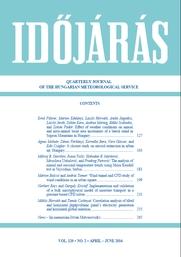IDŐJÁRÁS - angol nyelvű folyóirat
Vol. 120, No. 2 * Pages 127–266 * April - June 2016
 |
|
Effect of weather conditions on annual and intra-annual basal area increments of a beech stand in the Sopron Mountains in Hungary
Ernő Führer, Márton Edelényi, László Horváth, Anikó Jagodics, László Jereb, Zoltán Kern, Andrea Móring, Ildikó Szabados, and Zoltán Pödör
idojaras.2016.2.1 (p. 127–)
Ernő Führer, Márton Edelényi, László Horváth, Anikó Jagodics, László Jereb, Zoltán Kern, Andrea Móring, Ildikó Szabados, and Zoltán Pödör
idojaras.2016.2.1 (p. 127–)
A closure study on aerosol extinction in urban air in Hungary
Ágnes Molnár, Dénes Párkányi, Kornélia Imre, Vera Gácser, and Edit Czágler
idojaras.2016.2.2 (p. 163–)
Ágnes Molnár, Dénes Párkányi, Kornélia Imre, Vera Gácser, and Edit Czágler
idojaras.2016.2.2 (p. 163–)
Analysis of annual and seasonal temperature trends using the Mann-Kendall test in Vojvodina, Serbia
Milivoj B. Gavrilov, Ivana Tošić, Slobodan B. Marković, Miroslava Unkašević, and Predrag Petrović
idojaras.2016.2.3 (p. 183–)
Milivoj B. Gavrilov, Ivana Tošić, Slobodan B. Marković, Miroslava Unkašević, and Predrag Petrović
idojaras.2016.2.3 (p. 183–)
Wind tunnel and computational fluid dynamics study of wind conditions in an urban square
Márton Balczó and András Tomor
idojaras.2016.2.4 (p. 199–)
Márton Balczó and András Tomor
idojaras.2016.2.4 (p. 199–)
Implementation and validation of a bulk microphysical model of moisture transport in a pressure based CFD solver
Norbert Rácz and Gergely Kristóf
idojaras.2016.2.5 (p. 231–)
Norbert Rácz and Gergely Kristóf
idojaras.2016.2.5 (p. 231–)
Correlation analysis of tilted and horizontal photovoltaic panel’s electricity generation and horizontal global radiation
Miklós Horváth and Tamás Csoknyai
idojaras.2016.2.6 (p. 255–)
Miklós Horváth and Tamás Csoknyai
idojaras.2016.2.6 (p. 255–)
News-In memoriam István Matyasovszky (1960–2015)
Judit Bartholy
idojaras.2016.2.7
Judit Bartholy
idojaras.2016.2.7
IDŐJÁRÁS folyóirat

Az IDŐJÁRÁS a HungaroMet Nonprofit Zrt. negyedévenként megjelenő angol nyelvű folyóirata
Megrendelhető a journal.idojaras@met.hu címen.
A szerzőknek szánt útmutató itt olvasható.
Megrendelhető a journal.idojaras@met.hu címen.
A szerzőknek szánt útmutató itt olvasható.









